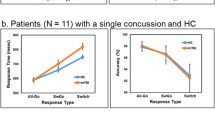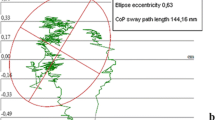Abstract
A test of whether patients suffering from a severe closed-head injury (CHI) were affected by disproportionate dual-task costs compared to those of healthy control participants was carried out through a direct comparison of CHI effects on dual-task (psychological refractory period, or PRP) performance and on single-task performance. In the dual-task condition of the present experiment, independent choice-responses were required to two sequential stimuli presented at a variable stimulus onset asynchrony (SOA). A significant delay of the reaction time (RT) to the second stimulus was reported by both CHI patients and controls at short (SOA) compared to long SOA, i.e., a PRP effect. The PRP effect was more pronounced for CHI patients than controls. In the single-task condition, a single choice-response was required to a stimulus presented in isolation. The RT produced by CHI patients in the single-task paradigm was longer than the RT produced by controls. CHI effects on dual-task performance and on single-task performance were compared following (1) their transformation into Cohen’s ds, and (2) the application of a correction algorithm taking into account the different reliability of single-task and dual-task measures. The analysis of Cohen’s ds revealed that CHI effects on performance were, if anything, smaller in the dual-task condition than in the single-task condition. The results imply that CHI patient’s slower responding in single- and dual-task performance reflects a single common cause—slowing of the central processing.


Similar content being viewed by others
References
Brooks, D. N. (1984). Closed head injury: Psychological, social, and family consequences. New York: Oxford University Press.
Cohen, J. (1988). Statistical power analysis for the behavioral sciences. Hillsdale (NJ): Lawrence Erlbaum Associates.
Dell’Acqua, R., Stablum, F., Galbiati, S., Spannocchi, G., & Cerri, C. (2001). Selective effect of closed-head injury on central resources allocation: Evidence from dual-task performance. Experimental Brain Research, 136, 364–378.
Dell’Acqua, R., Pashler, H, & Stablum, F. (2003). Multi-tasking costs in CHI-patients: A fine-grained analysis. Experimental Brain Research, 152, 29–41.
Ferraro, F. R. (1996). Cognitive slowing in closed-head injury. Brain and Cognition, 32, 429–440.
Gronwall, D. M. A., & Whrightson, P. (1975). Cumulative effect of concussion. Lancet, 2, 995–997.
Hein, G., Schubert, T., & von Cramon, D. Y. (2005). Closed head injury and perceptual processing in dual-task situations. Experimental Brain Research, 160, 223–234.
Hunter, J. E., & Schmidt, F. L. (1990). Methods of meta-analysis: Correcting error and bias in research findings. Newbury Park, CA: Sage Publications.
Jennett, B., & Bond, M. (1975). Assessment of outcome after severe brain damage. Lancet, 1, 480–484.
Jennett, B., Snoek, J., Bond, M. R., & Brooks, N. (1981). Disability after severe head injury: Observations on the use of the Glasgow Outcome Scale. Journal of Neurology, Neurosurgery, and Psychiatry, 44, 285–293.
Leclercq, M., Couillet, J., Azouvi, P., Marlier, N., Martin, Y., Strypstein, E., & Rousseaux, M. (2000). Dual task performance after severe diffuse traumatic brain injury or vascular prefrontal damage. Journal of Clinical and Experimental Neuropsychology, 22, 339–350.
Levin, H. S., & Grossman, R. G. (1979). The Galveston Orientation and Amnesia Test. A practical scale to assess cognition after head injury. Journal of Nervous and Mental Disease, 167, 675–684.
McCann, R. S., & Johnston, J. C. (1992). Locus of the single-channel bottleneck in dual-task interference. Journal of Experimental Psychology: Human Perception and Performance, 18, 471–484.
Miller, E. (1970). Simple and choice reaction time following severe head injury. Cortex, 6, 121–127.
Park, N. W., Moscovitch, M., & Robertson, I. H. (1999). Divided attention impairments after traumatic brain injury. Neuropsychologia, 37, 1119–1133.
Pashler, H. (1994). Dual-task interference in simple tasks: Data and theory. Psychological Bulletin, 116, 220–244.
Pashler, H., & Johnston, J. C. (1989). Chronometric evidence for central postponement in temporally overlapping tasks. Quarterly Journal of Experimental Psychology, 41A, 19–45.
Pashler, H., & Johnston, J. C. (1998). Attentional limitations in dual-task performance. In H. Pashler (Ed.), Attention (pp. 155–189). Hove, UK: Psychology Press.
Richer, F., Bédard, S., Lepage, M., & Chouinard, M.-J. (1998). Frontal lesions produce a dual-task deficit in simple rapid choices. Brain and Cognition, 37, 173–175.
Ruthruff, E., Van Selst, M., & Johnston, J. C. (2005). How does practice reduce dual-task interference: Integration, automatization, or just stage-shortening? Psychological Research (in press).
Schubert, T. (1999). Processing differences between simple and choice reactions affect bottleneck localization in overlapping tasks. Journal of Experimental Psychology: Human Perception and Performance, 25, 408–425.
Spinnler, H., & Tognoni, G. (1987). Standardizzazione e taratura italiana di test neuropsicologici [Standardization for Italian of neuropsychological tests]. Journal of Neurological Sciences, Supplementum 8.
Stablum, F., Leonardi, G., Mazzoldi, M., Umiltà, C., & Morra, S. (1994). Attention and control deficits following closed head injury. Cortex, 30, 603–618.
Van Selst, M., & Jolicoeur, P. (1994) A solution to the effect of sample size and skew on outlier elimination. Quarterly Journal of Experimental Psychology, 47A, 631–650.
Van Selst, M., & Jolicoeur, P. (1997). Decision and response in dual-task interference. Cognitive Psychology, 33, 266–307.
Welford, A. T. (1959). Evidence of a single-channel decision mechanism limiting performance in a serial reaction task. Quarterly Journal of Experimental Psychology, 11, 193–210.
Author information
Authors and Affiliations
Corresponding author
Rights and permissions
About this article
Cite this article
Dell’Acqua, R., Sessa, P. & Pashler, H. A neuropsychological assessment of dual-task costs in closed-head injury patients using Cohen’s effect size estimation method. Psychological Research 70, 553–561 (2006). https://doi.org/10.1007/s00426-005-0016-4
Received:
Accepted:
Published:
Issue Date:
DOI: https://doi.org/10.1007/s00426-005-0016-4




